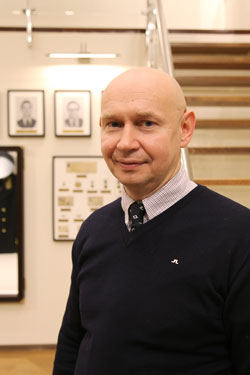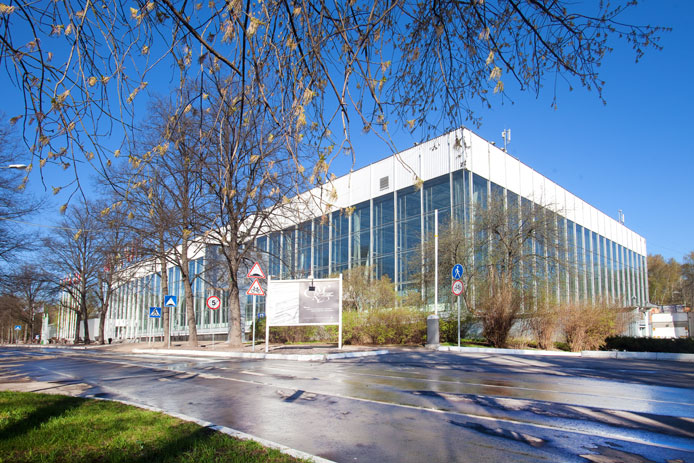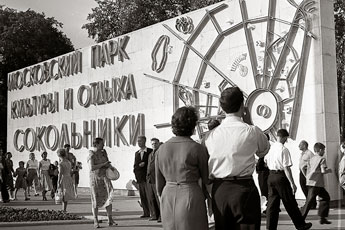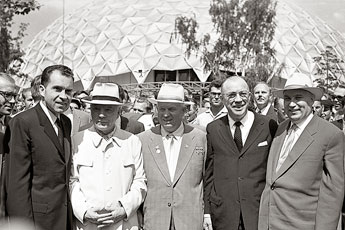A. Shaburov: “I pay tribute to alma mater”
One Sunday afternoon in the beginning of the 90s Alexey Shaburov, who has just returned from the army, came to Sokolniki Park to walk and visit a German exhibition. ‘I don’t remember what products the Germans had on show, but my memory has well preserved the conversation I had with one of the organizers of the exhibition. I was a well-educated young man, always read a lot and was interested in many things, that was why I made a good first impression on this man. It was Viktor Ivanovich Demidov, a former diplomat who took up the exhibition business after leaving the Ministry of Foreign Affairs. His advantage was the understanding of how exhibitions are organized in the West; the main problem was the lack of intelligent people. What were the people doing at that time? Some people were trading, some were dividing, and some were robbing. Only a few were creating”.

Alexey liked the idea of arranging exhibitions, but at that moment his priority was education. He was already enrolled in one of the universities that were springing up all over the place like mushrooms after rain . But Demidov said, “You’d better go to a serious institute like MGIMO. You will study and work”. “I am very grateful for his advice” said Shaburov “Because frankly speaking at school I was dreaming about entering MGIMO”.
Today Alexey Shaburov (MP, 1999) is the President of the International Exhibition Centre Sokolniki. In 2010, when he became the head of the International Exhibition Centre, Sokolniki annually held 23 exhibitions, now it holds 170! The turnover of the area has soared from 5 to 70 percent! It is not a coincidence that the rector of MGIMO A.V. Torkunov specially requested Shaburov to help revive the university museum. “I gladly agreed. By doing this I am, in a way , paying my debt to MGIMO. Without the education I received there I would have never achieved such success in life”.
But twenty years ago when he joined Demidov’s company, exhibition business practically did not exist in Russia. If in the West its history had many centuries, in our country its development stopped with fairs. “It is explained by the fact that the Soviet Union did not have a capital model with competition among manufacturers and their goods. Economy had a commanding character: what range of goods is ordered from above , such is the range of goods produced by factories and presented at the exhibition. Meanwhile, abroad an exhibition was a place of natural selection. And if the goods were not wanted, the manufacturer had to think about it: shall we stop producing these goods, purchase different equipment and next year bring new goods to the exhibition? During the Soviet period no-one thought about it, an exhibition at Sokolniki was just a dog and pony show”.
He had to start from scratch. Demidov was right, an international law degree , a specialist with good knowledge of English which he advised to Shaburov was very important at that time. “Seventy percent of our clients who exhibited their goods at the premises of Sokolniki were foreigners; the Germans, the Dutch, the French saw Sokolniki as a springboard to capture the Russian market which was huge and in fact empty. I remember when Germans came from Sheremetevo with huge suitcases stuffed with West German marks! They understood that they should hurry to capture the market before the Russian industry got to its feet”.
Since many industries in the 90s were really in ruins, for example there was no furniture industry, the exhibition business did not develop as well. “We could not use the Western system of exhibition organization as it had the following principle: goods should be exhibited directly by the manufacturers and factories, while dealers and resellers should come and sign contracts to purchase them. In Russia it was vice versa: manufacturers made only 30 percent of exhibition participants, all the rest were dealers. In this business such a ratio is considered to be an indicator of a very low quality”.
At the same time Alexey Shaburov was learning the basics of international commercial law at the International Law Faculty headed by its permanent dean G.P. Tolstopyatenko. “It was not studies, but some kind of a hurricane! It was rather hard, after the years spent at the production site and in the army my mind forgot how to learn. I spent 18 hours at the institute, slept in the library. I have no idea how I was able to develop the business and maintain my family, at that time I already had two children! With great zeal I took up even those special courses that I did not have in my curriculum, for example a course in diplomacy read by professor Zonova or the first Russian ambassador in the Vatican Vyacheslav Kostikov - I just thought that I should take as much as possible from the institute. And of course I tried not to miss the speeches of the world’s leaders who visited MGIMO. It was amazing when you could ask questions to the people of such a high level as UN Secretary General Kofi Annan or Jacques Chirac whom you could otherwise see only on TV!”
In 1999 his studies were finally over, the crises of 1998 had also passed, and Shaburov realized that the time for serious business development had finally come. “Having shared all his knowledge with me, V.I. Demidov retired and I created the International Exhibition Company (IEC) which would organize exhibitions in Sokolniki. I began travelling round the world, visiting various big trade-shows, auto shows, establishing connections, integrating into international associations, collecting books about exhibition activities from everywhere. I also studied, for several years I used to live in this atmosphere 24 hours a day, learning all the aspects of the exhibition business - and there is a great many of them! You can’t just come to the market and say, “I’ll arrange an exhibition”. It will be a failure. You should study all aspects of a certain industry in detail, better several industries - furniture, machinery, packaging, printing... I have collected so much knowledge that I started to write my own thematic works in accordance with which I trained my personnel. Even experts from other regions where exhibition business was under development came to my master classes”.
Shaburov’s company was formed in a scientific way, as it was taught at MGIMO, but every new level to be reached sometimes opened his eyes to a serious inconsistency between Russian and world’s standards. “As soon as we got to the organization of big international exhibitions, we faced the refusal of big companies to participate. It turned out that they totally refused to accept our standard constructor– booths sized 10х10, 5х5 and 6х6. “We won’t be able to fit in this space”, said the representative of the well-known company Heidelberg when we invited it to participate in the show “Poligraphiner”. “We, said the Germans, need a two-storey stand!” And then I began developing a separate segment in my enterprise - construction. I founded a mini-factory which on the bases of engineering calculations could build any construction which could also be transformed with the help of different additional elements”.
At some point Shaburov realized that his business exceeded the site in Sokolniki. “When the area taken for exhibitions exceeded 40,000 sq. m., I gradually began to move to Crocus. It happed with the furniture project that we grew up to 150,000 sq. m. in three or four years! This is the level of a good furniture salon in Paris. I am proud of this project and consider this exhibition my first serious achievement because we managed to unite not only the best manufacturers from Russia but from Europe in general. They presented their goods in a variety of segments including special furniture: for kindergartens, hospitals, etc. The exhibition was buzzing, dealers from all over the country came there in order to sign contracts!”
By 2010 the IEC was one of the three leading exhibition companies. “I had 800 employees (1000 in the exhibition season). I owned 25 projects recognized and certified by the Global Association of the Exhibition Industry (UFI), each of them fully complied with key requirements: firstly, by the level of participating international companies (not less than 40 percent) and manufacturers (at least 50 percent); secondly, by the number of employees knowing foreign languages; thirdly, by the level of modern technology applied. Some of my exhibition projects were original and unique, for example Poligraphinter or RosUpack - which occupied more than 10, 000 sq. m. (the second-largest exhibition was held in the Expocentre but there it was only 1,000 sq. m.)” .
In 2010 something that any business owner secretly hopes for happened. The British holding IТ Group made Alexey Shaburov an offer to sell the IEC. “It was an unexpected but pleasant offer. First of all, because a serious Western company recognized that in ten years I had created an efficient and interesting business. Besides, the exhibition business is not oil production; it is rather specific, too much connected to square meters, amounts and time factor. Thus, its turnover is limited, and it is difficult to enlarge it. That is why I thought it over and agreed. We made the biggest deal in the international exhibition community. And for me it was some kind of Christmas present”.
As usual in such cases Alexey faced the question: what to do next? Maybe change his life completely and take up something totally different? In his mind he had the example of Richard Branson who started with selling records and was now building tourist spacecrafts. “No” laughs Shaburov “I will assert myself in a different way! Although I would fly into space for free. By the way, I have already been to the North Pole - that is enough for me”.
For a while Shaburov was thinking about investing in overseas business, however when he was offered a post of the President of the International Exhibition Centre Sokolniki and for more credibility a share in the business, he readily agreed. “I realized that, firstly, I don’t want to leave Russia which I love a lot, and secondly, the exhibition business is a thing I understand best. Although, the nature of IEC business is a bit different: it is not arranging exhibitions but accommodating them which makes it even more interesting!”

Actually Shaburov started from scratch again. In four years he created a young professional team, led the company to a qualitatively new level: created new infrastructure, modern pavilions with the latest equipment, a web-site with a Chinese version as the IEC has many partners in Asia.
But the exhibition business, which became the work of his life, did not let him go. “I own two exhibitions which I hold twice a year - a horse show and Wanexpo. They are quite profitable projects, but I do it for my soul”. However, Shaburov’s main interest is the Museum of Calligraphy. He has a huge collection, one of the largest in the world - more than 4, 000 unique works. “Why calligraphy? I was attracted by its deep philosophy. Calligraphy is not an art, but a cure and gymnastics for a person’s mind and soul. When a patient with impaired manual dexterity writes, his health condition improves. That is why apart from excursions for the never-ending stream of school children and adults we arrange classes for patients from rehabilitation centers and hospitals. At our school of calligraphy, where even Chinese masters come to teach, children and adults study the art of beautiful handwriting. Such is the strong social role which the museum plays in the life of Sokolniki district and the whole Eastern district of Moscow”.
The exposition of the Museum of Calligraphy was held in MGIMO; the International Exhibition of Calligraphy which was held in St. Petersburg several years ago had been opened by V.P. Vorobyov who was still the vice-rector of the university at that time. “When at the request of Anatoliy Vasilevich Torkunov I undertook the task of reconstructing the MGIMO Museum and came into the university library in September, it was a utility area. My designer and I made some sketches, she created a design layout, all the rest was just technical: with the help of the Alumni Association we managed to put the sites in order and placed the exhibits in three months. However, the museum will continue to change, it is a living space”.
Alexey Shaburov remembers well that summer day when he came to Sokolniki for the first time and saw a famous pavilion dome constructed in 1959 and designed by an American architect Richard Fuller specially for an American exhibition which was visited by Richard Nixon and Nikita Khrushchev. “Unfortunately the dome was taken apart and moved away; it is kept on the territory of a military unit. I have searched the archives and found the people who organized that exhibition, interpreters. I want to revive this construction, return it to its original place. If the Worker and Kolkhoz Woman is a symbol of VDNKh, the famous dome at the exhibition in Sokolniki is an inseparable part of Moscow’s history”.



